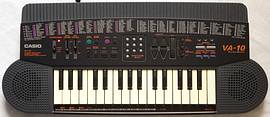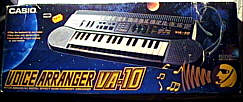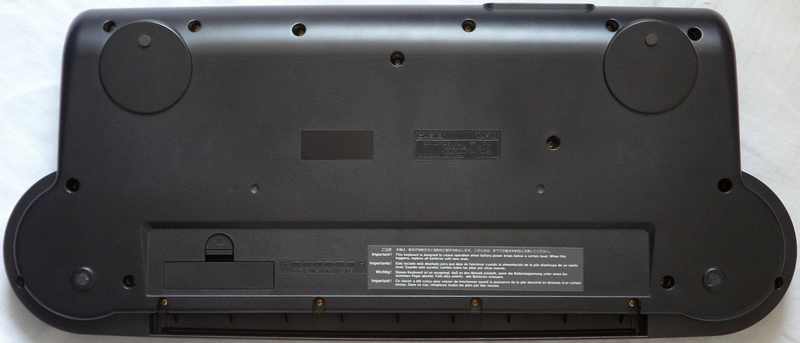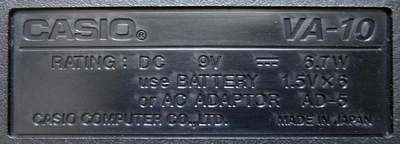 |
|
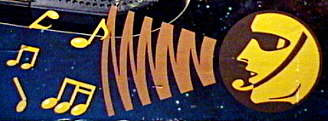 small
digital synth keyboard with effect processor & sing input small
digital synth keyboard with effect processor & sing input |
This very interesting Casio keyboard from 1992..1993 (embossed
case date) has a built-in digital effect processor with microphone input,
which can produce many kinds of reverberations, pitch shifting, vibrato/
tremolo, chorus, flanger (sounds like mellow tape mess, but is great for
celestial sound pads) and some very weird howling feedback/ LFO sounds
those resemble much to 1950th horror or psycho thriller movie effects.
The instrument is also claimed to have a vocoder function, but this effect
is rather fake, because unlike a genuine vocoder it seems to completely
ignore the timbre of the input signal but only controls the keyboard sound
volume by the microphone volume, thus it could be best described as an
envelope follower or "1-band vocoder" (however it can sound nice and quite
vocoder-like, by skilful playing the right keyboard notes to simulate timbre
changes). There are also some odd and very poor sounding other effects
in it; e.g. "distortion" sounds extremely harsh and digital (like a badly
clipping transistor amp). The keyboard has even a monophonic "pitch sensor"
feature which is claimed to convert sing input into keyboard notes, but
this revolutionary function works so badly that it is basically unusable
because it continuously jumps to wrong octaves.
Generally this keyboard's sound quality is partly very lo-fi and at
the edge between toy and real instrument, thus it is likely no replacement
for a modern studio effect processor. (The initial retail price had been
about 199€, which later dropped to 49€.) But due to the effects
can drastically modify the 100 fixed preset keyboard sounds and each effect
can even be adjusted by up to 2 parameters (e.g. intensity and frequency)
using drumpad buttons, the DSP feature should be mainly understood rather
as a versatile digital synthesizer function than a serious effect processor.
This hardware was one of a kind that AFAIK was never reused in any other
Casio keyboards.
main features:
-
32 midsize keys
-
2 built-in speakers (hissy and bassless)
-
stereo (effects stereophonize the initially mono keyboard and microphone
sounds)
-
polyphony 6 notes
-
100 preset sounds {piano, elec piano 1, honky-tonk, harpsichord, toy piano,
jazz organ 1, street organ, pipe organ, church organ, elec organ, brass
1, horn, trumpet 1, warm brass, tuba, fat brass, oboe, saxophone, bagpipe,
clarinet, flute, whistle, ocarina, recorder, harmonica, pop-lead 1..2,
synth-lead 1..3, strings 1, ensemble 1, violin, viola, cello, harp, pizzicato
1, shamisen , pizzicato 2, mute guitar 1, wood bass, elec bass, synth-bass,
gut guitar, dist guitar 1, acous guitar, elec guitar, jazz guitar, mute
guitar 2, dist guitar 2, jazz organ 2, e. clavier, accordion, elec piano
2, power-lead, brass 2..3, trumpet 2, strings 2, pulse vocoder, choir 1..2,
wav voice, choir 3, glass harmonica, cathedral, banjo, church bells, twinkle
echo, synth-guitar, airplane, cosmic dance, insect, emergency alarm, laser
beam, pearl drop, telephone, car horn, computer sound, sample percussion,
marimba, xylophone, afro percussion, bells, gamelan, vibraphone, steel
drum, music box, rock drum, disco drum, bass/ guitar, bass/ trumpet, bass/
piano, bass/ lead, piano-strings, marimba-strings, flute-vib, wind ensemble,
choir 4, ensemble 2}
-
12 preset rhythms {rock, disco, swing 2 beat, swing 4 beat, samba, bossa
nova, beguine, tango, march, slow rock, waltz} (without chords)
-
59 built-in preset effect combinations (each consist of 1 or 2 combined
basic effects) {small hall, large hall, stadium, disco, metallic room,
delay, stereo delay, pitch shifter, dual pitch, ensemble, flanger A..B,
chorus, distortion, tremolo, vibrato, heavy vibrato, panning A..B, vocoder,
distortion/ flanger, distortion/ stadium, chorus/ delay, chorus/ small
hall, flanger/ delay, flanger/ small hall, small hall/ vibrato, vibrato/
small hall, vibrato/ chorus, vibrato/ tremolo, ensemble/ small hall, ensemble/
delay, ensemble/ flanger, dual pitch/ small hall, dual pitch/ delay, tremolo/
small hall, tremolo/ flanger, delay/ flanger, large hall/ panning, stereo
delay/ small hall, heavy vibrato/ stereo delay, heavy vibrato/ chorus,
random vibrato/ small hall, pitch shifter/ small hall, pitch shifter/ chorus,
pitch shifter/ feedback, distortion/ small hall, distortion/ delay, transpose/
chorus, transpose/ small hall, ensemble/ panning, dual pitch/ panning,
heavy vibrato/ panning, tremolo/ panning, small hall/ panning, distortion/
panning, vocoder/ small hall, vocoder/ stereo delay, vocoder/ flanger,
non effect}
-
9 effect memory user presets
-
pseudo- vocoder (envelope follower)
-
"pitch sensor" sing- to- note converter which shall permit to play keyboard
notes by singing, but it is almost unusable because it works only reliable
within about 1 octave and otherwise randomly jumps to wrong octaves.
-
5 drum pads, switchable by 3 buttons to play 2 drum kit (A=normal, B= synth
toms/sirens) or as effect intensity controls
-
record/ playback sequencer
-
"harmony arranger" (some kind of chord sequencer?)
-
PCM sound generator like SA-series
instruments.
-
complex multi-chip hardware:
-
CPU= "NEC D911GF 003, 9243AA005, Japan" (120 pin SMD)
-
DSP?= "OKI M6583-04, 2432202, Japan" (60 pin SMD)
-
DRAM= "Toshiba TC51832APL-85, 9236HAK, Japan" (28 pin DIL, 32KB pseudo-static)
-
op-amp= "XRAI5218, 245 214A" (8 pin DIL, PCB label "M5218APR")
-
power amp= "Motorola AN8056, 2'D6" (28 pin DIL)
-
3x resistor array= "B9HC0118, 101Kx8, 2N" (9 pin SIL, PCB label "CNB8X101K")
-
resistor array= "B9XC0118, 101Kx7, 20" (8 pin SIL)
-
6 fusion/ synth pop demo tunes
-
uncomfortable headphone- style microphone
-
microphone jack (mono), phones jack
 |
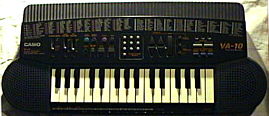 |
eastereggs:
-
This instrument can make even stranger noises by feeding its own sounds
through the microphone back into the voice changer. The results are e.
g. very eerie, droning, booming and disharmonious noises those can be compared
best with the horror movie music that Oskar Sala composed on the instrument
"Mixtur- Trautonium" (but the "feedback" effect can do some similar sounds
also internally). Also somewhat acid- like tweeting can be produced this
way.
modifications:
-
microphone headset bow was way to tight and almost crushed my head =>plastic
bent under hot water to make it fit less uncomfortable.
notes:
Although the main voice preset sounds resemble much Casio
SA series keyboards, the main ICs strongly differ from all other
small Casio keyboards.
It's a pity why Casio didn't make the keyboard note pitch freely
playable through the "pitch sensor" without the 12 notes per octave rasterization.
Also a simple sampling feature (like in the Casio
SK-1) would have extended the capabilities of this instrument a
lot, and the keyboard should be longer than 32 keys.
Someone now fortunately e-mailed me the manual of this instrument and
explained how the "harmony arranger" works. This is what he wrote about
it:
I bought this recently and found that I was quite disappointed
in it till I tried the harmony arranger. When you record your solo
and press the 'harmony arranger' button, the keyboard creates the backing
track with all the chords. You can refine the tune by pressing the
'melody quantize' button which then moves the notes to the nearest precise
timing (if that makes sense). I was amazed that on my first attempt
at using this feature, I had created a nice little tune with my fumbles
on the keyboard :) It's great for working things out very
quickly.
hardware details
The Casio VA-10 is based on the CPU "NEC D911GF 003" with 32KB external
RAM "Toshiba TC51832APL-85" and an IC "OKI M6583-04" that may be a DSP.
The double sided PCB is fairly complex with 3 large digital ICs and plenty
of discrete components. The CPU "D911GF" is such exotic, that not even
Google
finds its name. As expected, also the "OKI M6583" has no datasheet, but
plenty of Mitsubishi ICs with "M6583..." (different pin count) are audio
delay DSP for reverb and echo effects in things like karaoke machines,
so technical relations would be very plausible. (Yet I haven't analyzed
the hardware further.) |
A far relative of VA-10 was the unique fullsize midi keyboard Casio
CTK-1000 ("IXA Sound Source" with digital effect buttons, similar
design, velocity), but the hardware uses larger ICs and no related parts.
| removal
of these screws voids warranty... |
|
|
 |

|
|
| |
back
|
|

 small
digital synth keyboard with effect processor & sing input
small
digital synth keyboard with effect processor & sing input
 small
digital synth keyboard with effect processor & sing input
small
digital synth keyboard with effect processor & sing input